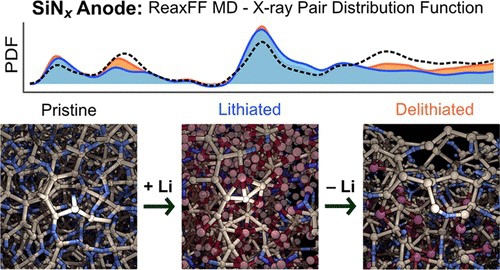The advanced anode materials for the future Li-ion batteries are often based on silicon, which is not only one of the most abundant elements, but also has an astonishing Li storage capacity. However, silicon suffers from various degradation processes which can be mitigated through the preparation of the silicon-based compounds. Among those is substoichiometric silicon nitride (SiNx), which has previously demonstrated a remarkable cycling stability even though the actual chemical mechanism of its operation is still not fully understood. In the reported work we have demonstrated a computational technique, which allows to reveal the chemical transformations in SiNx taken place during lithiation and delithiation. Furthermore, this atomistic modeling can be verified through pair distribution function (PDF) – an experimental technique for characterization of the local structures in amorphous materials such as SiNx. As a result, the developed platform will facilitate the further research conducted at NAFUMA group in the field of battery materials.
Park, H., van Duin, A. C. T., Koposov, A. Y. (2023). Toward Atomistic Understanding of Materials with the Conversion–Alloying Mechanism in Li-Ion Batteries. Chemistry of Materials, 35 (7), 2835-2845. https://doi.org/10.1021/acs.chemmater.2c03603.
